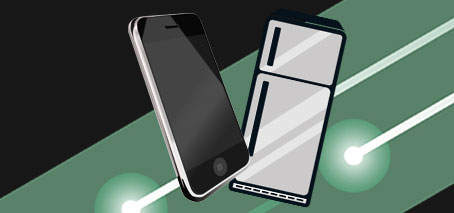Or, why we dropped a super-persuasive fact.
It’s a much-quoted ‘fact’ that your smartphone uses more electricity than your fridge.
And it’s very persuasive, particularly if you work (as we do) in the field of low-energy electronics. The entire field is predicated on the fact that computing/electronics use an unsustainable amount of electricity. And because most people don’t think of computing energy being significant, persuading them of that fact first is important. So in FLEET’s first year we told people this fact a few times. We even had it on our brochure.
(This was in the old days when we had physical events and printed out actual brochures on paper.)
The problem is that the comparison is… well, not quite dodgy, but not tight enough that we decided we were comfortable using it.
The fridge vs phone comparison first came from this 2013 study which received some criticism as picking out some high numbers to make the case. This is a useful contemporary discussion of how the comparison was made, and some criticism, and a good discussion in this 2017 article.
These comparisons are hard to make. But while it’s almost certain that there exists someone’s phone that uses more power than a fridge, we felt it’d be misleading to say it was always the case. And just confusing and unpersuasive to spell out all the caveats.
Compared with a 5star fridge (say, <350kWh/yr), some estimates of a smartphone put it above 400kWh/y.
BUT, it depends on
- (a) how you assess embodied energy (~half as much per unit for the phone, but smartphones only kept for 3-5yrs, cf a fridge 10+)
- (b) how you allocate datacentre/network ‘energy costs’ to each ‘customer’. As much as half of a data-centre’s costs are consumed whether or not any calculations are done, ie, “idle” servers still consume 50% of electricity of servers at peak use, so it’s our “peak” use of the net (early evening when we all sit down in front of Netflix) that determines much of that datacentre chunk of energy (a third of ICT total, and rising). One quoted figure is 19kWh/GB, plus a “flagfall” amount for being connected to networks (approx 25kWh/yr)**
- (c) how much data you assume each smartphone uses. The most commonly quoted study (link below) assumes 1GB/month, some people argue this is too high, particularly over data (see (d), below…) Others argue it’s too low (by ~half).
- (d) assumption re how much data used by smartphone is over cellular data system, versus how much is used at home on wifi. This is a massive determinant of how much energy is used in systems accessed by the phone. Depends on plans from service providers, lifestyle, etc.
**The popular 2013 article that got everyone using this comparison used quite a low value for kWh/GB. but perhaps too high a value for GB/yr over data).
A 2012 estimate of electricity worldwide for all ICT from van Heddeghem et al. (link needed) was 900 TWh/y, which works out to around 130 kWh/y for every single person on the planet, so that works out to be similar to one fridge (300-400 kWh-yr) per household. But that’s all of ICT, not just mobile phone usage. Still, this probably shows that it’s not a ridiculous comparison, just hard to prove or disprove.

